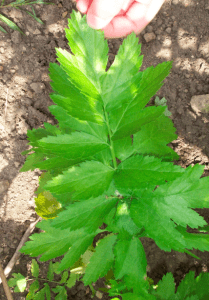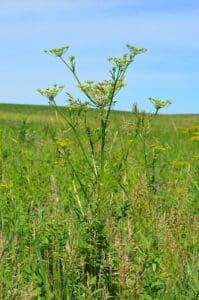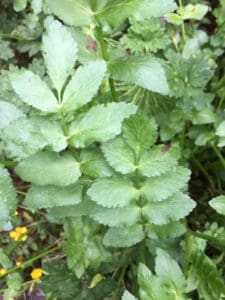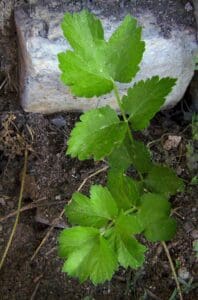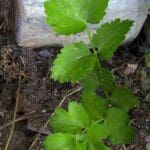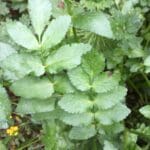Wild Parsnip / Spring / Summer / Winter
Wild Parsnip could look like quite a few of the umbelifer (Carrot family) species and some are deadly toxic so great care should be taken.
Common names
Wild Parsnip
Botanical Name
Pastinaca sativa
Scientific Classification
Kingdom – Plantae
Order – Apiales
Family – Apiaceae
Physical Characteristics of Wild Parsnip
Wild Parsnip is an erect strong smelling hollow stemmed biennial, with fine hairs on the leaves, growing up to 150cm in height.
Leaves
Emerge in a rosette, large alternate leaves, compound, compound and branched with jagged teeth. Leaflets are yellowish green, ovate, and coarsely toothed.
Flowers
Flowers grow in umbels. An umbel is a cluster of flowers where stalks of nearly equal length grow from a common point and form a curved or flat surface which is characteristic of the Apiaceae family. The flowers are yellow/green and there are 5 tepals, (sepals/petals not distinguishable), which curve inwards. The stamens project above the flower and produce yellow pollen grains.
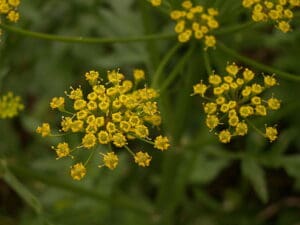
Seeds
Flattened brown ovoid smooth seeds with ribs on the side, with conspicuous oil tubes. At full maturity it splits into two seeds.
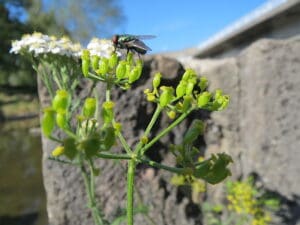
Root
Looks very similar to cultivated parsnip with a long cream coloured tap root.
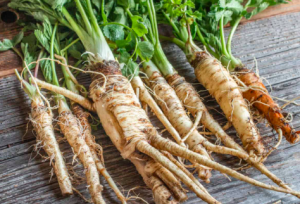
Habitat
Native to England, common in the South and Southeast, and Wales. Casual elsewhere in the UK and can be found throughout most of Europe except the extreme North of the continent.
Rough grassland, roadside verges, hedge banks, waste ground, on calcareous soils.
Known Hazards
Caution must be taken when handling the leaves and stems of this plant as it contains the same photo-toxic chemicals as Giant Hogweed, furanocoumarins, which can cause severe blistering in sunlight.
The leaves and seeds both contain high levels of furanocoumarins and although some people may be able to tolerate them as a leafy vegetable or seasoning, extreme caution is advised in case of an adverse reaction, especially if you have a Celery allergy.
Could be confused with;
Wild Parsnip could possibly be mistaken for Wild Angelica as the leaves of both plants are similar, although the leaves of Wild Parsnip are more elongated and 1-pinnate as opposed to Angelica which are 2-3-pinnate. The other difference is the colour of the flowers. Wild Parsnip flowers are yellow, whereas Angelica flowers are a delicate pale pink to white. They also prefer different habitats. Wild Parsnip like dry calcareous soils. Angelica prefers to have it’s roots wet and grows in marshes, wet meadows, wet woodlands, river and lake margins.
Positive identification is essential if digging the roots to consume as the roots of highly toxic Hemlock Water Dropwort (Oenanthe Crocata) are also very similar in appearance.
Edible Uses
Roots
The roots are a very common vegetable in the UK over winter. They need to be harvested in their first year as they become very woody once the plant has flowered. Wild Parsnip roots tend to be longer and pointier than our cultivated varieties which makes them slightly more prone to breaking when digging up, but they are just as tasty nevertheless.
Parsnips are ubiquitous on dinner tables at Christmas, roasted and smothered in gravy. They also make delicious crisps when thinly sliced and fried or roasted, are great pureed or mashed and are excellent in soups and stews adding sweetness.
The roots also make an excellent beer and wine.
Leaves
Young leaves can be cooked and added to dishes like any other leafy vegetable.
Seeds
Can be used as a Dill-like seasoning.
Notes on Herbal Uses
Parsnip stimulates appetite, endocrine gland activity and metabolism. It strengthen the walls of capillaries, relieves spasms, has a strong diuretic effect and promotes the elimination of stones and salts. In traditional medicine, it has a long history of use as a treatment for urolithiasis, bronchitis, and laryngitis, as a nutritive to restore strength to convalescents and as a vasodilator.
Parsnip leaves have been used in dermatology.
Extra notes from the Foragers
Has been cultivated as a root vegetable since at least the early Greeks and was part of a tribute offered to the Roman emperor Tiberius by the Germans. The Romans believed it was an aphrodisiac. In Europe, the root was used as a source of sugar before cane and beets became available.
The genus Pastinaca means “parsnip” and is thought to be from the Latin pastus, meaning ‘food’. The species sativa means “cultivated” as this plant is the ancestor of the cultivated parsnip sold in the shops today.



